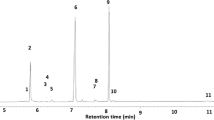Abstract
Samples of female coyote urine were taken once or twice each week during the winter and spring for two years. Headspace analysis was employed with Tenax GC trapping and GC-MS. Tenax trapping was started in less than 1 hr after sampling, and mild conditions were used to minimize losses of highly volatile and labile compounds. Thirty-four compounds were identified. They include sulfur compounds, aldehydes and ketones, hydrocarbons, and one alcohol. The principal constituent is methyl 3-methylbut-3-enyl sulfide, which usually comprised 50% or more of the total volatiles observed. The concentration of many constituents varied widely. This appeared to be quasiperiodic for five of the constituents, with a period of a few weeks, and with pronounced maxima at the peak of estrus. Apparently these compounds are 3-methyltetrahydrothiophene, methyl 3-methylbutyl sulfide, octanal, dodecanal, and bis(3-methylbut-3-enyl) disulfide. One or more of these compounds may have pheromonal activity in coyote relationships.
Similar content being viewed by others
References
Albone, E.S., Eglinton, G., Walker, J.M., andWare, G.G. 1974. Anal sac secretion of the red fox (Vulpes vulpes).Life Sci. 14(2):387–400.
Bailey, S., Bunyan, P.J., andPage, J.M.J. 1980. Variation in levels of some components of the volatile fraction of urine from captive red foxes (Vulpes vulpes) and its relationship to the state of the animal, pp. 391–403,in D. Mueller-Schwarz and R.M. Silverstein (eds.). Chemical Signals: Vertebrates and Aquatic Invertebrates. (Proc. Symp.) 1979. Plenum, New York.
Bekoff, M., andWells, M.C. 1986. Social ecology and behavior of coyotes.Adv. Study Behav. 16:251–338.
Fagre, D.B., Howard, W.E., Barnum, D.A., Teranishi, R., Schultz, T.H., andStern, D.J. 1983. Criteria for the development of coyote lures, pp. 265–277,in D.E. Kaukeinen (ed.). Vertebrate Pest Control and Management Materials: Fourth Symposium, 1982, ASTM STP 817. American Society for Testing and Materials, Philadelphia.
Goodwin, M., Gooding, K.M., andRegnier, F. 1979. Sex pheromone in the dog.Science 203:559–561.
Jorgenson, J.W., Novotny, M., Carmack, M., Copland, G.B., andWilson, S.R. 1978. Chemical scent constituents in the urine of the red fox (Vulpes vulpes L.) during the winter season.Science 199:796–798.
Kruse, S.M., andHoward, W.E. 1983. Canid sex attractant studies.J. Chem. Ecol. 9(11):1503–1510.
Matsumoto, K.E., Partridge, D.H., Robinson, A.B., Pauling, L., Flath, R.A., Mon, T.R., andTeranishi, R. 1973. The identification of volatile compounds in human urine.J. Chromatogr. 85:31–34.
Murphy, E.L., Flath, R.A., Black, D.R., Mon, T.R., andTeranishi, R. 1978. Isolation, identification, and biological activity assay of chemical fractions from estrous urine attractive to the coyote, pp. 66–77,in R.W. Bullard (ed.). ACS Symposium Series 67, American Chemical Society, Washington, DC.
Preti, G., Muetterties, E.L., Furman, J.M., Kennely, J.J., andJohns, B.E. 1976. Volatile constituents of dog (Canis familiaris) and coyote (Canis latrans) anal sacs.J. Chem. Ecol. 2:177–186.
Raymer, J., Wiesler, D., Novotny, M., Asa, C., Seal, U.S., andMech, L.D. 1986. Chemical scent constituents in urine of wolf (Canis lupus) and their dependence on reproductive hormones.J. Chem. Ecol. 12(1):297–314.
Schultz, T.H., Flath, R.A., andMon, T.R. 1971. Analysis of orange volatiles with vapor sampling.J. Agric. Food Chem. 19:1060–1065.
Schultz, T.H., Kruse, S.M., andFlath, R.A. 1985. Some volatile constituents of female dog urine.J. Chem. Ecol. 11:169–175.
Scrivner, J.H., Howard, W.E., andTeranishi, R. 1984. Aldehyde volatiles for use as coyote attractants, pp. 157–160,in D.O. Clark (ed.). Proceedings Eleventh Vertebrate Pest Conference, University of California, Davis, California.
Teranishi, R., Murphy, E.L., Stern, D.J., Howard, W.E., andFagre, D. 1981. Chemicals useful as attractants and repellants for coyotes, pp. 1839–1951,in J.A. Chapman and D. Pursley (eds.). Worldwide Furbearer Conference Proceedings, Vol. 3. Worldwide Furbearer Conference, Inc., Frostburg, Maryland.
Wilson, S.R., Carmack, M., Novotny, M., Jorgenson, J.W., andWhitten, W.K. 1978. Delta3-isopentenyl methyl sulfide. A new terpenoid in the scent mark of the red fox (Vulpes vulpes).J. Org. Chem. 43(24):4675–4676.
Author information
Authors and Affiliations
Rights and permissions
About this article
Cite this article
Schultz, T.H., Flath, R.A., Stern, D.J. et al. Coyote estrous urine volatiles. J Chem Ecol 14, 701–712 (1988). https://doi.org/10.1007/BF01013917
Received:
Accepted:
Issue Date:
DOI: https://doi.org/10.1007/BF01013917




